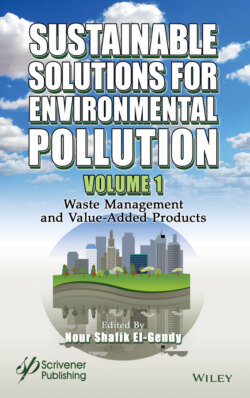Читать книгу Sustainable Solutions for Environmental Pollution - Группа авторов - Страница 2
Table of Contents
Оглавление1 Cover
4 Preface
5 1 An Overview of Electro-Fermentation as a Platform for Future Biorefineries 1.1 Introduction 1.2 Fundamental Mechanisms 1.3 Value-Added Products from Electro-Fermentation 1.4 Challenges and Future Outlook 1.5 Acknowledgements References
6 2 Biodiesel Sustainability: Challenges and Perspectives Abbreviations 2.1 Introduction 2.2 Biodiesel Production 2.3 Factors Affecting Biodiesel Production Process 2.4 Transesterification Mechanisms 2.5 Production of Biodiesel Using Heterogeneous Catalyst Prepared from Natural Sources 2.6 Challenges and Perspectives References
7 3 Multidisciplinary Sides of Environmental Engineering and Sustainability 3.1 Introduction 3.2 System Theory and Integrated System Approach 3.3 Sustainable Development, Sustainable Development Engineering and Environmental Engineering 3.4 Advanced Multi-Disciplinary Sustainable Engineering Education 3.5 Novel Designs for Auto-Thermal Behavior Towards Sustainability 3.6 Conclusions References
8 4 Biofuels 4.1 Introduction 4.2 Composition 4.3 Classification of Biofuels 4.4 Examples of Biofuels 4.5 Property Variations with Source 4.6 Properties Compared to Fuels from Crude Oil Tar Sand Bitumen, Coal and Oil Shale 4.7 Fuel Specifications and Performance 4.8 Conclusion References
9 5 Sustainable Valorization of Waste Cooking Oil into Biofuels and Green Chemicals: Recent Trends, Opportunities and Challenges 5.1 Introduction 5.2 Waste Cooking Oil (WCO) 5.3 Biofuels from WCO 5.4 Green Chemicals from WCO 5.5 Challenges and Future Work 5.6 Conclusion References
10 6 Waste Valorization: Physical, Chemical, and Biological Routes 6.1 Background 6.2 Land Biomass vs. Oceanic Biomass 6.3 Waste Management 6.4 Waste Valorization for Adsorbents Development 6.5 Waste Valorization for Catalysts Preparations 6.6 Bio-Based Waste Valorization for Bio-Fuel and Bio-Fertilizer Production 6.7 Biochemical Mechanism Involved in Anaerobic Digestion System 6.8 Challenges and Recent Advances in Anaerobic Digestion 6.9 Bio-Based Waste and Bioeconomy Perspective 6.10 Conclusion References
11 7 Electrocoagulation Process in the Treatment of Landfill Leachate 7.1 Introduction 7.2 Decomposition of Solid Waste 7.3 Landfill Leachate Properties 7.4 Characteristics of Landfill Leachate 7.5 Electrocoagulation Process 7.6 Key Parameters of Electrocoagulation Process 7.7 Operating Mode 7.8 Economic Analysis 7.9 Case Study: Removal of the Organic Pollutant of Colour in Natural Saline Leachate from Pulau Burung Landfill Site 7.10 Gaps in Current Knowledge 7.11 Conclusion and Future Prospect References
12 8 Sustainable Solutions for Environmental Pollutants from Solid Waste Landfills 8.1 Introduction 8.2 Domestic Solid Waste and Its Critical Environmental Issues 8.3 Landfill Leachate Characterization and Its Impact on the Environment 8.4 Effect of Landfills on Air Quality 8.5 Effect of Unsuitable Location of Landfill on Environment and Community 8.6 Recent Sustainable Technologies for Leachate Treatment 8.7 Sustainable Solutions for Gas Emission 8.8 Consideration for Selection of Sustainable Locations for Landfills 8.9 Conclusion References
13 9 Progress on Ionic Liquid Pre-Treatment for Lignocellulosic Biomass Valorization into Biofuels and Bio-Products 9.1 Introduction 9.2 Lignocellulosic Biomass for Biofuels and Bio-Products 9.3 Pre-Treatment Technologies for Lignocellulosic Biomass 9.4 Ionic Liquids for Lignocellulosic Biomass Pre-Treatment: Characteristics and Properties 9.5 Insights into Pre-Treatment Performance of Ionic Liquids 9.6 Concluding Remarks: Challenges Facing the Development of Ionic Liquids Use at Large Scale and Future Directions References
14 10 Septage Characterization and Sustainable Fecal Sludge Management in Rural Nablus – Palestine List of Abbreviations 10.1 Introduction 10.2 Septage Characteristics 10.3 Study Methodology 10.4 Septage Pre-Treatment Process 10.5 Results and Discussion 10.6 Pre-Treatment of the Fecal Sludge – Results and Discussions 10.7 Treatment Plant Estimated Cost Breakdown 10.8 Conclusion 10.9 Recommendations References
15 11 Lipase Catalyzed Reactions: A Promising Approach for Clean Synthesis of Oleochemicals 11.1 Introduction to Oleochemicals Industry 11.2 Sources of Lipases 11.3 Application of Lipases 11.4 Lipase Catalyzed Production of Biodiesel 11.5 Esterification of Fatty Acids with Glycerol 11.6 Interesterification 11.7 Environmental Benefits of Enzymatic Process Against Chemical Process 11.8 Conclusion References
16 12 Seaweeds for Sustainable Development 12.1 Introduction 12.2 Types of Seaweeds 12.3 Bioremediation 12.4 Seaweeds in Nutrition 12.5 Seaweeds as a Source of Pharmaceutics 12.6 Seaweeds Hydrocolloids and Biopolymers 12.7 Seaweeds and Bioenergy 12.8 Seaweeds as Biofertilizers 12.9 Seaweeds as Ecological Player in Sulfur Geocycle 12.10 Culturing Seaweeds in the Marine Habitat (Algal Maricultures) 12.11 Conclusion 12.12 Recommendations References
18 Index
